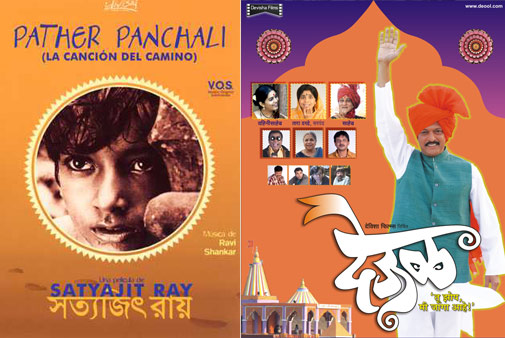It is irking to notice that while Bollywood is enthralling over Bombay Talkies and how Indian cinema turns a century old this year, it has completely omitted the influence and presence of vernacular cinema. Strictly maintaining centenary year celebrations to Bollywood is erasing a large repertoire of unbelievably fabulous works. Diversity is the most omnipresent characteristic of the Indian soil, from languages to ethnicities, there isn’t another place on the globe so pluralistic in its nature.
I too had been an all Bollywood person for a long time. But regional cinema hit me when I was introduced to the wonders of Bengali cinema. Satyajit Ray, Ritwik Ghatak have made a couple of unforgettable pieces that has immortalized itself in the history of Indian cinema. When Google presented Satyajit Ray with an endearing tribute by doing a doodle on the late director’s birthday, that particular scene from Pather Panchali flashed irreplaceably in my head. There are scenes etched in my memory of what I fondly remember as guidebook of understanding nitty gritties of cinema, the world deems getting introduced to unparalleled brilliance. Ray’s Pather Panchali still scores as the first film to get widened global acclaim and 11 International Awards.
Marathi cinema too gradually evolved through the 60s and the 70s. It was with directors like V Shantaram, Acharya Atre and mostly Dada Kondke who made films which became classics. Delving into social issues with satires and puns, his work is reflective of the rebel strain of film making that disappeared through the 90s. His 1971 classic Songadya, that still remains an example of iconic Marathi cinema!

It would be a mistake to assume that vernacular cinema has lost itself in the ocean of mediocrity, swaying to the beats of poorly made songs. While Bollywood came of age gradually, so did vernacular films evolve in their character! Be it the National Award winning film Marathi film Deool, to rare concepts of the crisis of haunted house for ghosts embedding it in a comedy in the Bengali film Bhooter Bhobishyot, vernacular films indeed form a large part of great cinema that is forgotten to be encapsulated in the 100 years celebrations!
Have you ever heard of Mani Ratnam’s Nayagan? While we all are aware of Aamir Khan’s jubilatory inclusion in the TIME 100 most influential people, very few are even aware of this Mani Ratnam film which feature in TIME magazine’s 100 All Time Best Films. After Hindi films, Tamil films hold the record of being the second language that has the maximum films submitted as India’s official nomination to the Oscars.
The charm of 35 mm that most Indians understand is in their vernacular dialect. Few of India’s most commendable films are made in other languages. Yet, it is the commercialism of Bollywood that retains its sheen. They make more money, their profit margins are larger and hence they garner the command to dominate the film scenario in India. Yet, what art means in concept, presented with artistic inclination, celebration of creativity, meticulous execution and mostly what motivates good cinema -visibility! The visibility of vernacular is vast, but elitist tendencies ignore such wonderful efforts. And with the commemoration of Indian cinema’s century mark, it is offensive to see it as a Bollywood affair. Where are our vernacular films? And where is the tribute to those film makers who thrived only for their creative excellence without any commercial backing! 100 years of Indian cinema is meaningless without the vast repertoire of vernacular films!



 Follow Us
Follow Us
![Did You Know? Sacred Games’ ‘Bipin Bhosle’ Girish Kulkarni Has Won 2 National Awards In A Single Year – [Fact-O-Meter] Did You Know? Sacred Games' 'Bipin Bhosle' Girish Kulkarni Has Won 2 National Awards In A Single Year - [Fact-O-Meter]](https://www.koimoi.com/wp-content/new-galleries/2020/11/did-you-know-sacred-games-bipin-bhosle-girish-kulkarni-has-won-2-national-awards-in-a-single-year-fact-o-meter-001-218x150.jpg)








